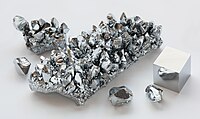
Photo from wikipedia
Abstract Chromium oxide-doped borate glasses with composition xP2O5-(70-x) B2O3- 29.5Li2O-0.5 Cr2O3 (x = 0.0, 0.5, 1.0, 1.2, 1.5 and 2.0 mol %) were prepared following the melt quenching technique. A detailed deconvolution process,… Click to show full abstract
Abstract Chromium oxide-doped borate glasses with composition xP2O5-(70-x) B2O3- 29.5Li2O-0.5 Cr2O3 (x = 0.0, 0.5, 1.0, 1.2, 1.5 and 2.0 mol %) were prepared following the melt quenching technique. A detailed deconvolution process, applied to their optical absorption spectra, revealed distinct optical transitions from Cr6+/Cr3+ in the ultraviolet/visible spectral regimes, which are simultaneously tuned through slight P2O5 additives. This tuability is mainly derived by the ligand field experienced by the optically-active Cr6+/Cr3+ ions. Interestingly, the intensity reduction of Cr6+/Cr3+ transitions with P2O5 contents allowed smooth variations of the glass color and unravel the, otherwise masked, optical band gap of the homogenous glass host. The coexistence of Cr6+ and Cr3+ was, further, confirmed by mapping its oxidation states via electron spin resonance spectroscopy, while structural rearrangements, produced by P2O5, and Cr6+ vibrational signal were inferred from infrared spectroscopy. The rich optical transitions provided by the coexistence of Cr6+ and Cr3+ within the same host and their simultaneous tuability should find applications in multifunctional optical devices operating in the ultraviolet and visible spectral regimes.
Journal Title: Journal of Alloys and Compounds
Year Published: 2018
Link to full text (if available)
Share on Social Media: Sign Up to like & get
recommendations!